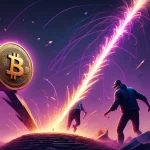Ripple XRP Escrow Dump Myth Busted as Price Surges Past $3

Ripple XRP Escrow Dump Rumors Debunked Amid $3 Price Surge
Is Ripple quietly sabotaging XRP investors with monthly token dumps, or are critics just fanning flames with no fuel? As Ripple unlocks more tokens from its escrow account, advocates like legal consultant Bill Morgan and Versan Aljarrah of Black Swan Capitalist are stepping up to dismantle the tired narrative that these releases are a cash grab at holders’ expense. With XRP’s price soaring recently, the truth might just burn down this persistent myth.
- Escrow Overview: Started with 55 billion XRP in 2017, now down to 35 billion, with monthly releases aimed at market stability.
- Price Defiance: XRP skyrocketed from $0.50 to over $3.00 between November 2024 and January 2025 despite ongoing unlocks.
- Advocate Defense: Experts argue releases ensure liquidity and attract investors, not manipulation, backed by data and even SEC insights.
Understanding Ripple’s XRP Escrow System
Let’s get down to brass tacks about Ripple’s escrow mechanism, a system that’s been both a shield and a lightning rod since its inception. In 2017, Ripple locked away 55 billion XRP—over half of the total 100 billion supply—into an escrow account to prevent market flooding and signal trust to investors. The structure is straightforward but deliberate: 55 contracts, each containing 1 billion XRP, were set to release monthly over a 55-month period starting January 2018, often in two 500-million token batches. Typically, 650 to 800 million XRP go unused each month and are returned to escrow, maintaining a tight rein on supply entering circulation. As of a recent update from legal consultant Bill Morgan on X, the escrow balance stands at roughly 35 billion XRP. For the uninitiated, escrow in this context means tokens are held in a secure account and released on a predetermined schedule, ensuring predictability in a market often defined by chaos. If you’re curious about the deeper mechanics, a detailed overview of the Ripple XRP escrow system can provide further clarity.
Ripple’s stated goal with this setup is to stabilize XRP’s price and provide liquidity—basically, ensuring there are enough tokens available to trade without causing massive price swings. It’s a stark contrast to Bitcoin’s supply model, where new coins trickle in via decentralized mining and periodic halvings. Ripple’s approach is more hands-on, reflecting its focus on institutional adoption, where large entities like banks need reliable access to tokens for things like cross-border payments. But this control is precisely why detractors keep hammering the same nail: they claim Ripple is “dumping” tokens to fund operations—think salaries and business ventures—while diluting value for everyday holders. It’s a gritty accusation, and honestly, it reeks of bias more than evidence. For a broader perspective on how this compares, check out this comparison of Ripple’s model versus Bitcoin’s supply dynamics.
Price Surge vs. Dump Fears: The Hard Numbers
If Ripple’s escrow releases are such a poison pill for XRP’s value, how do you explain the token’s meteoric rise from $0.50 to over $3.00 between November 2024 and January 2025? That’s a 500%+ jump while tokens kept trickling out of escrow, a fact that Bill Morgan argues should bury the dump theory once and for all. This isn’t just a random spike; it suggests market confidence in XRP despite the unlocks. Potential drivers behind this surge could include broader crypto bull runs—Bitcoin often drags altcoins up with it—new Ripple partnerships for payment solutions, or even positive regulatory developments. Whatever the mix, the data laughs in the face of claims that releases are a death knell. For a deeper dive into this trend, take a look at this analysis of XRP’s price surge and escrow impact.
Morgan also points out that the volume of tokens released monthly is a tiny fraction of XRP’s daily trading volume, meaning the market absorbs these unlocks without breaking a sweat. Think of it like adding a cup of water to a swimming pool—hardly a flood. Yet, skeptics persist with cries of “hollowed out loyalty XRP” being dumped to bankroll Ripple’s corporate machine. If XRP keeps climbing while tokens unlock, why are these dump fears still haunting the community? It’s starting to feel less like concern and more like a grudge.
“If it needed a coup de grâce to send it to its final resting place, it was the massive rise in XRP price… despite further releases,”
Morgan emphasized, driving home the disconnect between rumor and reality. He’s not just annoyed—he’s fed up with the narrative’s refusal to die.
“If the rate of release by Ripple remains steady and a day comes when 99% of XRP is in circulation and the escrow is down to 1 billion (1%) and Ripple releases 200 million XRP one month from escrow, people will still be carrying on about the escrow dump. The theory is odious,”
he vented. And let’s be real, when the numbers don’t add up, clinging to this theory starts looking like a personal vendetta against Ripple’s very existence.
Advocates Strike Back: Liquidity as a Lifeline
Stepping into the ring alongside Morgan is Versan Aljarrah, CEO of Black Swan Capitalist, who frames these escrow releases as a vital cog in XRP’s market health. For those new to the game, liquidity means how easily an asset can be bought or sold without causing wild price fluctuations. Too little liquidity, and trades grind to a halt; too much, and value tanks. Aljarrah argues Ripple strikes a balance by ensuring just enough XRP circulates to keep the ecosystem humming. For more on how these releases affect trading dynamics, see this take on XRP market liquidity effects featuring Aljarrah’s insights.
“Liquidity refers to the ease at which an asset can be bought or sold without significantly impacting its price. So by maintaining liquidity, Ripple is able to facilitate the smooth functioning of the XRP ecosystem. And that makes it more attractive to investors, traders, and potential partnerships,”
he explained. This isn’t just about retail traders flipping XRP on exchanges—it’s about making the token a viable tool for big players, like financial institutions using it for near-instant international transfers, a niche Ripple has targeted for years.
Even the U.S. Securities and Exchange Commission (SEC), during its high-profile 2020 lawsuit against Ripple for alleged securities violations, didn’t paint escrow as a villain. The lawsuit claimed Ripple raised $1.3 billion through unregistered XRP sales, with a 2023 ruling finding institutional sales in breach but clearing secondary market trades. Yet, on escrow specifically, the SEC saw it as a mechanism to support price stability, not sabotage it. You can explore the SEC’s stance in more detail through their official statements on the lawsuit and escrow’s purpose.
“Even the SEC recognised that the escrow was intended to buttress the price of XRP not deflate it. The SEC considered this to be one of the factors that would give investors an expectation of profits from the efforts of Ripple,”
Morgan noted, highlighting a rare moment where regulatory perspective aligns with Ripple’s defense. So if even the SEC isn’t buying the dump story, why are armchair critics still peddling it?
Centralization vs. Decentralization: The Ideological Clash
Zooming out, let’s tackle the elephant in the room: Ripple’s escrow system, and its broader control over XRP, reeks of centralization in a space that worships the opposite. Bitcoin’s supply, dictated by code and miners with no central puppeteer, embodies the “no middleman” ethos I champion as a Bitcoin maximalist. Ethereum, post-merge, leans on decentralized staking to manage its tokenomics. Ripple, by contrast, operates more like a tech company than a pure blockchain protocol, with escrow releases as a managed supply valve. This rubs decentralization purists the wrong way, and understandably so. When one entity holds the keys to 35 billion tokens, it’s hard to argue you’re fully aligned with crypto’s rebellious spirit. If you’re wondering about the core intent behind this setup, this discussion on the purpose of Ripple’s escrow system offers some community perspectives.
That said, let’s not pretend every project needs to mimic Bitcoin to have value. Ripple’s design prioritizes speed and cost-efficiency for institutional use—think banks settling transactions in seconds, not minutes or hours. Escrow releases are a pragmatic piece of that puzzle, providing predictable supply for partners who’d balk at Bitcoin’s volatility or Ethereum’s gas fee roulette. Critics aren’t wrong to question whether this corporate structure undermines XRP’s long-term credibility as a “true” cryptocurrency, though. Compared to competitors like Stellar (XLM), which also targets payments but with less centralized baggage, XRP’s perception problem lingers. It’s a tension that no amount of price surges can fully erase.
Regulatory Shadows: SEC Settlement and Beyond
Adding another layer of complexity is Ripple’s ongoing dance with regulators, which continues to fuel unease about its grip on XRP. In May 2025, a settlement with the SEC saw over $75 million returned to Ripple from escrow, with prior court injunctions vacated—a decision that didn’t sit well with everyone. SEC Commissioner Caroline Crenshaw slammed the move, arguing it undermines investor protections and creates a “regulatory vacuum” that erodes enforcement credibility. Her dissent isn’t directly about escrow dumps, but it underscores broader concerns about Ripple’s influence over XRP supply and market dynamics. If regulators are still uneasy, can investors fully trust the system, even with price data on their side?
This isn’t just regulatory noise—it hints at future risks for XRP’s ecosystem. While Morgan and Aljarrah see escrow as a stabilizing force, Crenshaw’s warning suggests centralized control could invite stricter oversight down the line. On the flip side, Ripple’s broader vision, as Aljarrah points out, includes integrating with global finance through initiatives like the RLUSD stablecoin—a token pegged to the U.S. dollar for stable transfers—and potential frameworks like the 2025 GENIUS Act, which could shape crypto’s role in tokenized assets, even U.S. debt. If escrow releases are part of building that bridge, they might be less a liability and more a stepping stone. Still, regulatory whiplash keeps the debate far from settled. For insights into how these releases might affect future price trends, this analysis of escrow impact on price stability for 2024-2025 featuring Morgan’s take is worth a read.
Community Sentiment and XRP’s Competitive Edge
Beyond expert takes, what’s the word on the street—or rather, on X and Reddit—about these escrow releases? Sentiment among XRP holders often splits down the middle: some echo the dump fears, accusing Ripple of prioritizing corporate gain over community trust, while others point to price gains and growing transaction volume on the XRP Ledger as proof of health. Hard data on institutional adoption remains patchy, but Ripple’s partnerships with financial firms suggest the liquidity argument holds water. If more banks and payment processors are engaging, escrow releases might indeed be greasing the wheels. For a raw look at community skepticism, this Reddit thread on XRP escrow dump rumors captures the ongoing debate.
Looking at the bigger picture, XRP’s role as a payment solution faces stiff competition from stablecoins like USDT or USDC, which offer price stability by design, and even other blockchain protocols like Stellar. Ripple’s escrow strategy could be a double-edged sword: it ensures supply for transactional use but keeps fueling centralization critiques that competitors dodge. For long-term viability, Ripple needs to keep proving that controlled releases translate to real-world utility, not just price pops. If they can’t, dump rumors might be the least of their worries. Recent efforts to clarify these concerns are highlighted in this report on advocates addressing XRP escrow dump rumors.
So where do we stand? The escrow dump theory feels more like a ghost story at this point, propped up by ideological distrust rather than cold, hard facts. XRP’s price surge, the logic of liquidity, and even historical SEC nods paint releases as a tool, not a weapon. Yet, centralization concerns and regulatory uncertainty ensure this debate won’t vanish anytime soon. For now, Ripple’s token unlocks seem less nefarious and more utilitarian—though in a space driven by ideals as much as tech, utility alone doesn’t win hearts. And hey, if XRP keeps soaring while critics grumble, maybe the naysayers will finally take a hint. I wouldn’t bet on it, though.
Key Takeaways and Questions on Ripple XRP Escrow Releases
- What’s the purpose behind Ripple’s XRP escrow system?
It locks up a massive portion of XRP supply, releasing tokens gradually to prevent market oversaturation, stabilize prices, and maintain liquidity for trading and institutional use. - Are escrow releases dragging down XRP’s value for investors?
Hardly—XRP’s price leaped from $0.50 to over $3.00 between November 2024 and January 2025 despite unlocks, showing releases aren’t the value-killer critics allege. - How does the SEC view Ripple’s escrow practices?
Even during its 2020 lawsuit, the SEC recognized escrow as a price-support mechanism, not a manipulative dump, countering accusations of harm to investors. - Why does the escrow dump theory refuse to fade?
Persistent distrust in Ripple’s centralized control over XRP supply fuels the narrative, even as price gains and data debunk the idea of market flooding. - How do releases impact XRP’s role in the crypto market?
They ensure liquidity, making XRP appealing for institutional applications like cross-border payments, aligning with Ripple’s goal of integrating into global financial systems. - How does Ripple’s escrow compare to other crypto supply models?
Unlike Bitcoin’s decentralized halving or Ethereum’s staking rewards, Ripple’s managed releases reflect a corporate approach, prioritizing predictability over pure decentralization.



